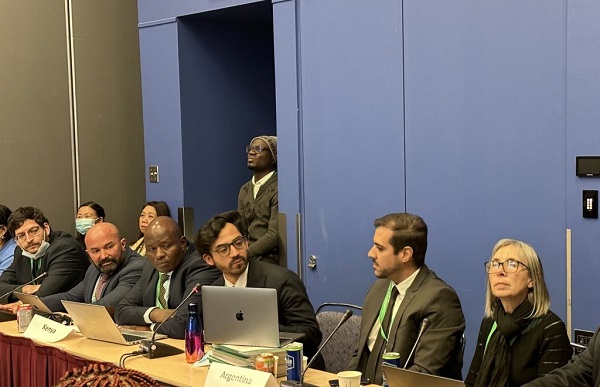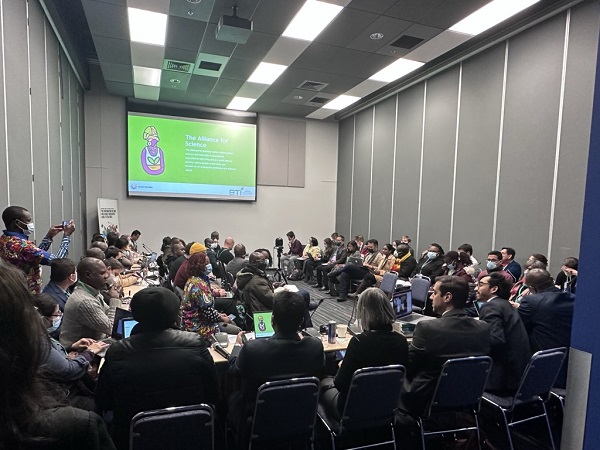Introduction
The 15th United Nations Biodiversity Conference of Parties (CBD COP15) witnessed the gathering of 196 countries and parties that are signatories to the Convention on Biological Diversity to discuss the preservation of the diversity of species, sustainably utilise the components of biodiversity and maintain life-supporting systems and essential ecological processes.
Also recorded were fast-paced negotiations and many side events at the just concluded meeting at the Palais des Congrès de Montréal, Canada.
As part of this important COP, parties negotiated a plan of action for the next 10 years to halt biodiversity loss and achieve sustainability. The plan is called the ‘Global Biodiversity Framework’ and it consists of goals and targets that all parties will seek to achieve. As part of this plan, biodiversity is a specific target.

The Side Event
Many parties, civil societies, academic and research institutions and other stakeholders believe that technology can be essential to achieving the objectives of the convention, just as Article 16 states. Also, biotechnology can help us achieve SDGs at a pace that keeps up with the biodiversity and climate crisis.
Led by Argentina, the Alliance for Science (AfS) under the Boyce Thompson Institute co-hosted a side event at COP15 along with Kenya, Nigeria, Brazil, Uruguay, Colombia and Paraguay, titled “The Contribution of Safe and Locally Developed LMOs to the Sustainable Development Goals”. This south-south initiative called for a balanced target on biotechnology. Parties and stakeholders agreed that it is imperative to recognise that biotechnology has positive impacts that can accelerate the achievement of the SDGs and the objectives of the convention.
Panellists from Argentina, Nigeria, Brazil and Kenya highlighted their countries’ achievements in approving locally developed and safe living modified organisms (LMOs) to address challenges in the agricultural sector to sustainably enhance food security in their respective countries. The panellists listed products, including drought-resistant soybeans and wheat in Argentina, genetically modified beans resistant to the golden mosaic virus in Brazil, Pod Borer Resistant (PBR) cowpea in Nigeria and virus-resistant cassava in Kenya.
Argentina
In her presentation, Argentina’s national director of bioeconomy, Dr. Dalia Lewi began by stating that her country’s “uttermost priority is supporting local developments” and that “Argentina has much capacity for innovation and resilience, as do all Latin American countries and the whole of the global south.” She then highlighted that her country, like most in Latin America, has adopted biotechnology as a tool to produce more with less through sustainable intensification. According to her, having technology developed in-country presents local solutions for local productive problems. “It is one of the things we are most proud of,” she said.
Listing wheat, soybeans and potatoes as some of the products developed through biotechnology in Argentina, Lewi asserted that recognising the benefits of locally produced LMOs and fostering them will encourage more local bio-developments that can help achieve sustainability and the objectives of the CBD and its protocols.
She stated that the agency’s focus is on growers – to improve their productivity while preserving environmental resources – and on consumers who receive innovative and better products. “Climate change is a reality and we are faced with the need for adaptation and mitigation of its effects. Biotechnology and, particularly, local developments, are going to be fundamental in the future.
“In this sense, according to what the countries committed to in the Paris Agreement and with the SDGs, it is necessary to take action for adaptation, mitigation and product sustainability. Biotechnology is one of the tools that can contribute to the [achievement of these] objectives.
“Regarding the post-2020 biodiversity framework, we are confident we can contribute towards most of the targets related to agriculture: targets 1, 7, 10, 14, 15, 16, 17 and18, all of which revolve around sustainably improving productivity, reducing the number of inputs for production, guaranteeing food security in the world, contributing to the resilience of productive systems and the conservation of biological diversity, promoting the circular bio-economy, etc.,” she added.
Kenya
As biotechnology continues to take root in Africa and boost food production to forestall projected famine and food insecurity, many have continued to sensitise stakeholders and governments to let the coming tide bring them the new rave: living modified organisms (LMOs).
Commenting at the side event, the chief executive officer of Kenya’s National Biosafety Authority (KNBA), Dr. Roy Mugiira said countries in the southernmost hemisphere can learn from each other in terms of biotechnology development and applications to strengthen and sustain their food security drive. Mugiira called the event “a perfect example” of how southernmost [countries] can learn and support one another in delivering beneficial products to the people.
As a representative of Kenya’s National Biosafety Authority, Dr. Josphat Muchiri and the principal investigator of the VIRCA Project, Kenya, Prof. Douglas Miano presented the case of GM cassava. The duo stated that the genetically modified cassava has been certified safe based on regulatory safety data. The duo said conclusively, that GM cassava is as safe as conventional cassava varieties, with the former demonstrating its socio-economic relevance by contributing to Kenya’s food security and economic growth through the management of the CBSD disease.
“Kenya learning from Nigeria, Nigeria learning from Argentina, Argentina learning from others and so on; this is an exciting moment, particularly, seeing the professor of cowpea there and professor of cassava at the other end. This is a perfect way of getting [the] south-south to talk to one another, to deliver science,” he said.

Nigeria
Speaking for the director-general of Nigeria’s National Biosafety Management Agency (NBMA), Dr. Rufus Ebegba, the agency’s head of planning, research and statistics, Mrs. Scholastica Bello said Nigeria is the first country globally to approve the cultivation of Bt cowpea. She further emphasised her country’s strides in the agricultural biotechnology sector wouldn’t have been possible without the establishment of the Biosafety Act 2015.
According to her, Nigeria has one of Africa’s safest biosafety systems, thanks to quality capacity and functional biosafety frameworks which regulate the technology from trial to commercialisation, after decades of research.
The hope is that more African countries will embrace agricultural biotechnology and build a hedge against the forecast food insecurity/famine by giving their citizens a variety of options and ensuring farming households and clusters get their hands on GMOs, with regulations and policies in place to avoid a conflagration of negative tendencies.
As an observer during the side event, the executive director of the Institute of Agricultural Research (IAR) Samaru, Nigeria, Prof. Mohammed Ishiyaku said researchers in Nigeria have reiterated their stand over the years of the potential of deployment of responsible use of science to solve national problems, especially leveraging on local capacities to solve these problems.
According to him, the development of drought-tolerant varieties, as seen in wheat and the reduction of very harmful insecticides in protecting crops against insect pests indicates the confluence of all the environmental concerns for which the convention of biodiversity rests, biotechnology has shown beyond doubt that it holds very high potential in ensuring development.
Ishiyaku, a plant breeder and principal investigator of Nigeria’s first genetically modified food crop – the Pod Borer Resistant (PBR) cowpea – maintained [that] this is only possible through an alloy of responsible regulation and very shrewd science driven by national commitment in those countries.
Brazil
Sharing the Brazilian experience, the technical assistant of Brazil’s National Biosafety Committee and its minister of science and technology, Gutemberg Sousa said his country currently boasts 410 institutes of biotech research, stating 80 per cent of research facilities belong to the public sector.
Speaking on the country’s key product, he stated that beans resistant to the golden mosaic are as safe for cultivation and consumption in Brazil as the frijol currently cultivated. Sousa maintained that new breeding, biotechnology, precision and risk assessment have formed part of a consistent process.
Bangladesh
As the only representative of civil societies and the CEO of Farming Future Bangladesh (FFB), Arif Hossain, presented on Bt brinjal. Hossain, who has worked with stakeholders in Bangladesh, stated that over 65000 farmers grow Bt brinjal in Bangladesh. Some of the key numbers regarding the positive impacts of Bt brinjal include a 51 per cent reduction in the number of applications of pesticides by farmers, a 39 per cent reduction in the quantity of pesticides applied, a 41 per cent reduction in the toxicity of pesticides applied, as measured by the Pesticide Use Toxicity Score (PUTS) and, more importantly, a 10 per cent reduction in the likelihood of reporting symptoms consistent with pesticide poisoning.
Hossain’s presentation included a video of farmer Milon Mia’s story. Mia’s accounts underscored the benefits of the technology as we can see what it means to the users of the technology from a farmer’s first-hand experience.
Conclusion
In a chat with our correspondent, global policy lead for the Alliance for Science, Pablo Orozco said the objective of the side event was to demonstrate that safe, sustainable, locally developed LMOs are available and can benefit local communities and regions through safe case studies. These studies, he said, show the improved crop’s traits and how they help achieve sustainability and how a national robust system contributes [to that].
“The objective, I believe, was achieved because Argentina, Kenya, Nigeria, Brazil and our civil societies’ representative from Bangladesh demonstrated how their bio-developments have already helped local communities accelerate progress towards the SDGs’ targets and how they will positively contribute to achieving them in the future. We had 15 parties in attendance, with many taking the floor in support of how modern biotechnology can contribute to the SDGs,” he said.
During the negotiations in Montreal, many parties and stakeholders agree with AfS on the benefits of biotechnology for conservation and for accelerating progress toward the SDGs. The AfS will continue to engage delegates on how biotechnology is an important tool to achieve sustainability within the post-2020 GBF timeframe.


